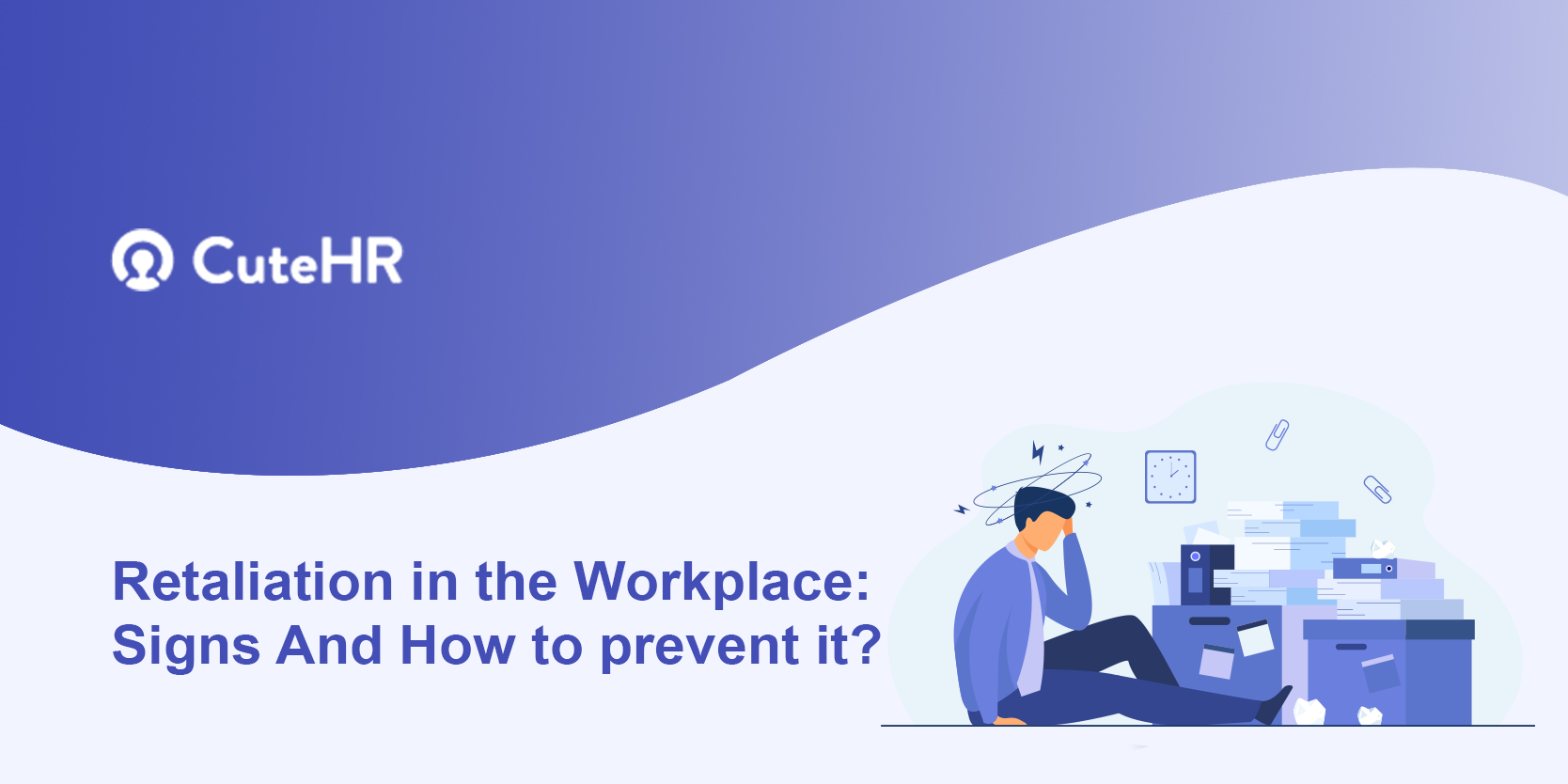03 May

According to the EEOC report, “one 2003 research indicated that 75 percent of employees who spoke out against workplace abuse suffered some type of retaliation in the workplace.”
Retaliation in the workplace comes in numerous shapes, counting untrue affirmations, line examination, boycotting, outlandish teaching, and wrongful end of representatives. Not as it were, can a retaliation in the workplace contribute to a harmful work environment, it can also lead to claims.
In this blog, we’ll get to know the definition of countering within the working environment, a few examples and conceivable signs, and how you’ll be able to avoid working environment retaliation in the workplace.
Table of Contents
What is Retaliation in the workplace?
Retaliation in the workplace occurs when one employee with authority exercises force against another employee with less power to negatively damage that individual’s career or professional progress in the business, or even how that person is seen by leadership. In other words, when retaliation in the workplace occurs, there is generally a power difference.
Employees frequently do this because they either did something that the other person(s) did not approve of or did not do something that they desired.
Retaliation can be either direct or indirect. As a result, seemingly lawful behaviors might be used to retaliate against an employee. Proving retaliation necessitates an extensive investigation and proof.
The Equal Employment Opportunity Commission (EEOC) considers submitting a complaint to be a “protected activity.” Because it is protected, an employer or other corporate leader may be prohibited from responding to the complaint in a disciplinary or improper manner.
The following are common responses from managers that the EEOC deems workplace retaliation:
- Submitting or testifying in an EEO charge, complaint, inquiry, or lawsuit
- Responding to inquiries during an employer inquiry of suspected harassment, refusing to execute orders that would result in discrimination.
- To detect possibly discriminatory pay, ask bosses or coworkers for compensation information.
- Opposing sexual solicitations or stepping in to protect others
- Speaking with a supervisor or manager about employment discrimination, including harassment
- Seeking a disability accommodation or religious practice
In the event of retaliation claims, it is HR’s responsibility to thoroughly investigate the claims, assess the findings, and make a decision that upholds the law, aligns with the organization’s code of conduct, and reinforces HR’s commitment to being objective, fair, and fostering a culture of psychological safety.
One of HR’s key responsibilities is to avoid retaliation in the workplace by collaborating with leadership to ensure a safe working environment for all workers. HR must educate leaders and managers on relevant regulations about protected classes and protected activities. Furthermore, the department must design and maintain rules that are consistent with the legislation, as well as hold all personnel to the same standards.
6 Important Signs of retaliation in the workplace
When it comes to managing people and leading businesses, legitimate judgments may not always delight all workers and may even be detrimental to some. The crucial question for leaders and managers is whether these actions constitute discriminatory treatment or harm protected classes.
They must also guarantee that the judgments are not used to retaliate against employees who engage in protected conduct.
Many of the retaliatory indications described below are sometimes required to successfully lead a business or team. As a result, an indication of retribution is simply that: “A sign”.
Employees should not presume that every unfavorable experience at work constitutes retaliation or discrimination until there has been a comprehensive investigation and proof of reprisal. If they have strong feelings about it, they should file a formal complaint with HR.
The following are the possible signs of retaliation in the workplace:-
Reduction in salary or loss of benefits
This might be followed by a demotion. It can also happen when an organization is going through financial hardship or restructuring. Wage reductions, on the other hand, must be justified, and there should be an associated policy describing when a salary decrease may be warranted. Retaliation may be the cause if there is no valid justification or a consistently enforced policy.
Demotion
This is an appropriate tool for leaders and managers. When an employee is not doing well, he or she may be demoted. However, if an individual is demoted for no apparent cause, it may constitute retaliation. Your company should have a policy in place that explains when demotions are possible.
Procedures for disciplinary action
Disciplinary processes are also valid tools that leaders must employ to ensure productivity, the quality of services and products, the protection of the business, and the development of a positive culture. However, when implemented, the penalty must be proportionate to the employee’s transgression.
A written warning placed on the employee’s file may be perceived as retaliation if a spoken warning suffices. If a written warning is the next logical step, demotion may be interpreted as retaliation.
Relocation
Relocation might be neutral in and of itself. However, relocating an employee to another team or location for engaging in protected behavior in retaliation, regardless of whether the job or income remains the same. It is not so much about the choice as it is about why the decision was reached.
Termination
This might be the most severe kind of retaliation in the workplace. ‘Employment-at-will’ allows employers to terminate an employee’s employment relationship with or without cause. Employers must, however, be accountable for carrying out this agreement to safeguard the company from future wrongful termination actions.
Hostility
Workplace hostility is never acceptable. It does, however, happen. When this occurs, it might be for a variety of reasons, one of which is retribution. According to the EEOC, workplace hostility is discriminatory in character, widespread, intense, and (clearly) undesirable. Hostility can manifest as:
- Emotional, verbal, or physical abuse
- Unfair and threatening inspection
- False rumors, slander, or defamation of the employee
- Making the individual’s task more difficult (for example, punishing an employee by changing their work schedule to conflict with family or other known commitments).
- Reprimanding the employee or providing an inadequate performance review.
- shaming the employee, particularly in public.
- Excluding the employee from initiatives or meetings that affect their job portfolio or over which they should have some say.
Retaliation in the Workplace: How you can prevent it?
Retaliation in the Workplace can be avoided if sufficient precautions are taken. To assist prevent Retaliation in the Workplace, follow these steps:
Set up a retaliation policy that outlines your company’s policies
By explicitly stating what constitutes retaliation in the workplace in a policy, you can educate and enlighten your employees and corporate executives.
Include a section in your employee handbook that defines workplace retaliation and details your anti-harassment and anti-discrimination policies. This policy should make workers feel comfortable addressing leadership or the human resources staff with any accusations of harassment, discrimination, or retaliation.
Provide these guidelines to all staff members
After your staff has had an opportunity to evaluate these guidelines and regulations, give training sessions to ensure they grasp the rules completely. Hold an employee training session to define retaliation in the workplace. It is also possible to train human resource personnel on how to handle allegations of retaliation. Organize a final workshop to teach managers how to avoid retaliation in the workplace.
After you’ve completed these training sessions, give an official document proving it. Each staff member should sign and date the paper to demonstrate that they have attended the training and understand the material presented. Save these papers for future use.
Report all disciplinary actions to human resources
If a supervisor is punishing an employee for legitimate reasons, he or she should notify human resources before meeting with the employee. Tell the manager to document the cause for the meeting, and have human resources authorize the disciplinary action before it is implemented. This helps guarantee that the remedy done is suitable if an employee alleges retaliation in the workplace.
Records of meetings and warnings should be kept
Each disciplinary or warning meeting should be documented by the supervisor to demonstrate that warnings were issued before taking action. Managers should also collect emails, files, and projects to illustrate the employee’s poor job performance or improper behavior. Keeping a large number of files that substantiate your company’s executives and supervisors’ activities can be an effective approach to prevent retaliation in the workplace.
Ensure the confidentiality of your employees’ information
If your employees have any complaints about business leaders, supervisors, or managers, encourage them to first speak with the human resources department. The human resources person should guarantee that the information shared by the employee in their meeting is kept secret. They should also ensure the employee that they will not face retaliation as a result of this complaint.
If an employee thinks they are the victim of workplace retaliation, a human resources staff member should review the employee handbook and go over your organization’s retaliation policy to ensure the employee’s allegation qualifies as retaliation in the workplace.
5 Crucial Types of retaliation in the workplace
Psychological harassment
Psychological harassment is equivalent to verbal harassment, but it is more subtle and involves exclusionary methods such as withholding information. It is the objective of these activities to mentally break down the victim, chip away at their self-esteem, and undermine them, according to Chancey.
The employee must not be badgered when they request credit for another’s work, receive excessive deadlines, or are forced to perform duties outside of their job obligations,” he stated.
Verbal harassment
Verbal harassment may be a never-ending fight that jeopardizes your health and job. It comprises derogatory words, unpleasant gestures, and irrational criticism. Inappropriate humor, insults, slurs, and harmful remarks come to mind.
Since verbal abuse is not physical violence, it is difficult to recognize and is often ambiguous.
Calling colleagues names, reviling, or making improper jokes around them is frequently respected as individual clashes instead of badgering, indeed in case it comes about in depression, high blood pressure, or anxiety,” Chancey said.
Physical harassment
It is possible to be physically harassed at the workplace in several ways. Those gestures can range from minor unpleasant gestures like touching an employee’s clothing, hair, face, or skin to more serious ones such as physical assault, threats of violence, and property destruction, according to Mooney.
It might be difficult to recognize because of the varying degrees of physical harassment. In Chancey’s opinion, some forms of physical harassment may be dismissed as jokes without causing bodily harm.
A coworker is always shoved, blocked, or kicked by an employee, but the victim is never injured as a result of When a supervisor or another high-performing employee kicks and shoves another, that may not be considered harassment,” he said.
Cyberbullying (digital harassment)
Cyberbullying is just as harmful as in-person bullying, regardless of whether it occurs online. A variety of media outlets may display this most recent form of harassment.
Among digital harassment are posting threats or degrading remarks online, creating a fake profile to intimidate someone, creating a webpage to mock and degrade someone, and making false charges online,” Sheri Mooney, CEO, and president of Mind Squad HR explained.
Because social media has become so prevalent in the workplace, and taboo topics have become more mainstream, Chancey believes it is now easy to digitally harass someone in the name of free speech or being “woke.”
“People are meaner behind a screen, despite looking bolder,” Garvin remarked. “The good thing about internet harassment is that it is readily documented and proven.” This is quite beneficial in terms of reporting and demonstrating it.”
Garvin advised collecting screenshots, storing emails on your computer, and creating a dossier of everything that makes you uncomfortable to keep track of the problem.
Sexual harassment
As you might imagine, sexual harassment is a serious offense that tends to happen more often than you think. Among ZipRecruiter respondents, 40% of women and 14% of men reported experiencing workplace sexual harassment. It is a common crime that is not limited to women. There can be sexual harassment perpetrated both by men and women.
Unwanted sexual approaches, such as improper touching, sexual jokes, exchanging pornography, sending sexual messages, or expecting sexual favors in return for a promotion or job stability, are examples of sexual harassment. Sexual harassment seems straightforward, but it’s not always so.
As Chancey pointed out, sexual harassment in the workplace is rarely extreme. Instead, it is usually concealed under harmless banter, inoffensive comments accompanied by suggestive gestures, or embarrassing comments that represent individuals of a certain gender (typically women) in an unfavorable light.”
Crimes can easily slip under the radar because of this gray area. As Mooney said, many victims do not want to be a focus of attention, so they keep everything to themselves in hope that things will improve. If they disclose the harassment, some victims are afraid of repercussions, including losing their jobs. If, on the other hand, someone is creating a hostile working environment and making you feel uneasy, you should register a complaint.
Is retaliation in the workplace illegal?
It’s not. Retaliation is only illegal when the activity that preceded the retaliation is legal. This varies by state. It is always illegal to retaliate against an employee for conduct such as sexual harassment, racial discrimination, and coordinated workplace activity. Some states provide whistleblower protections that protect employees who report any number of unlawful conduct, but not all.
If an employee files an unsubstantiated complaint, retribution may be lawful or criminal. For example, suppose Anne says that Vincent is sexually harassing her, and you check and discover that Vincent only asked her out once. You discovered that Anne said no, and he never harassed her again.
However, you cannot retaliate against Anne as long as she believes Vincent acted improperly. However, if you do an investigation and discover that Anne wants Vincent’s better shift so she made up her complaint, you can take action and retaliate.
Wrapping it up
Educating your workers about retaliation in the workplace, implementing clear and open rules, and cultivating a culture of trust will help you avoid retaliation in the workplace claims and guarantee your employees are treated fairly in all situations.
HR, which frequently acts as a go-between for employees and management, needs to feel empowered and supported to do the right thing for the business and the employees.
Frequently Asked Questions (FAQs)
What are examples of false workplace retaliation claims?
When an employee believes they are the victim of retaliation in the workplace, their supervisor’s actions may be justified. Here are some examples of when an allegation of workplace retribution may be false:
- If a supervisor has recorded evidence of an employee’s poor working performance and offers a negative rating.
- If a manager punishes an employee who consistently arrives late for work,
When an employee complains about workplace retaliation, what steps should be taken?
Whether one of your workers contacts a human resources staff and claims that a supervisor is retaliating against them, you can look into it to see if this is true. Request a meeting with human resources to hear about the supervisor’s perspective and to go through retaliation in the workplace and your policy on it.
You should also speak with any employees who observe regular interactions between the employee and the management to get a different perspective on the matter. You can then gather records and reports that may serve as evidence that the management retaliated against the employee or did not. When completing this research, keep all personal information private.












Himani